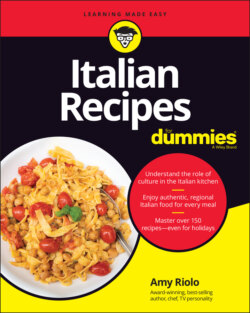Читать книгу Italian Recipes For Dummies - Amy Riolo - Страница 37
Staying the course: Italian meal planning
ОглавлениеOne of the biggest mistakes that non-Italians make when serving Italian food is not in the preparation of recipes themselves, but in the way that they are paired together. Fixed price “Italian” menus in the U.S. and United Kingdom, for example, often offer a soup as an appetizer and a pasta as a main course, which would never be done in Italy. Both soups and pasta dishes are considered first courses. Eating two together would not only be an overkill of calories and food groups, it would also take away from the integrity of each dish, which is meant to lead up to the second course.
These are the components of a traditional complete Italian meal, normally eaten at lunch (when the main meal of the day is eaten), but could also be eaten at dinner, especially if entertaining, or in a restaurant.
Antipasto: An appetizer begins the meal, although informal family meals and dinners at home might omit this course. Larger holiday meals or special occasion menus offer several appetizers.
Primo: A first course of pasta, gnocchi, risotto, or soup is always at lunch and sometimes at dinner. This is the heart of the Italian meal, and if you had to make only one dish and omit the rest, this course is it.
Secondo: A second course of seafood, fish, poultry, eggs, meat, or a vegetarian protein is usually served at lunch and dinner. On special occasions, there are several secondi, and at formal dinners you might have a few separate meat or seafood courses, starting with the lightest and ending with the more robust flavors.
Contorno: A side dish of cooked vegetables accompanies the secondo in the same course. Holidays and special occasions call for several contorni.
Insalata: A salad, most typically green or mixed, follows a meal at lunch or dinner.
Frutta/Noci: A plate of fruit, nuts, and/or cheeses usually follows the meal (sometimes by a few hours) and on regular days replaces dessert. In restaurants, this course is not as commonplace as it once was.
Dolce: A sweet dessert is usually not eaten at each meal at home, but always on Sunday and holidays and often in restaurants. At holidays and for special occasions, several types of desserts are served.
Caffé: An espresso coffee is considered to be the period at the end of a meal.
Digestivo: A digestive liqueur officially concludes a meal and helps to aid digestion.
